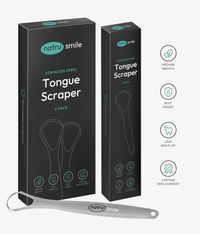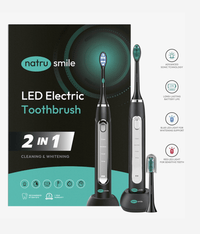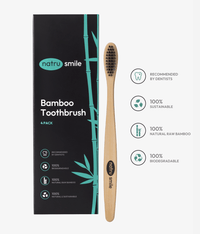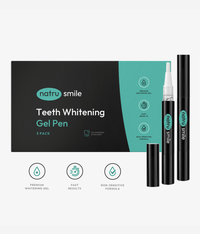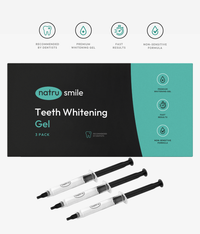
All products are certified by dental expert Dr. Greg Grillo
Artificial intelligence (AI) and machine learning have practically taken the world by storm.
As their (nearly) widespread adoption pertains to the human body, healthcare advancements usually come to mind. Nearly three-fourths of large healthcare organizations have invested over $50 million in AI projects, while 73% of all-sized organizations plan to increase their AI investments year over year, according to Deloitte's State of AI survey.
These numbers underscore a clear trend: AI-based technologies (and the awareness around them) are seemingly commonplace in the realm of human care.
In dentistry, AI is past the point of "showing potential"—it has now begun to improve the standard of treatment across most areas.
Let's explore some of the ways AI is transforming dental care for the better.
What Is Artificial Intelligence In Dentistry?
At its core, AI is nothing more than a computer program designed to learn, recognize patterns, and make decisions based on those patterns. It is called "artificial" intelligence because it imitates our cognitive ability—that is, to think, solve problems, and make logical decisions based on patterns.
Now that we have an understanding of what AI is and how it works in the realm
In the context of dentistry, AI refers to the integration of advanced algorithms and machine learning models to assist dental professionals in diagnosing, treating, and managing oral health issues. Its primary objective is to enhance the accuracy and efficiency of dental procedures, improve patient outcomes, and streamline practice management.
Researchers at the University of Hong Kong explain the nuances and applications of AI in dentistry in a systemic review of the technologies and industry as a whole. They explain that its uses can be broken up into four distinct classifications.
- Diagnosis
- Decision-making
- Treatment planning
- Prediction of treatment outcomes
Although this review touches on some of the most important elements of AI in actual practice, it doesn't cover the full scope of technological advances. In a broader sense, we can actually segment AI into just two main areas: clinical applications and administrative applications.
Clinical applications involve the above—using AI algorithms to analyze dental imagery, such as X-rays, CBCT scans, and intraoral photographs, to detect dental issues like cavities, gum diseases, and malocclusion, among others. They also include treatment planning, outcome simulation, and even full process automation (e.g., tooth segmentation and bracket placement in orthodontics).
Administrative applications involve leveraging AI to optimize appointment scheduling, patient communication, and billing processes, resulting in a more efficient dental practice.
When we look at AI through the lens of dentistry as a whole, "what it is" becomes much more clear: It isn't just improving dentistry, it's becoming a part of it.
A Brief History Of Artificial Intelligence In Dentistry
Understanding the broad impact of AI in dentistry requires a glimpse into its origins and how it started making waves in the industry.
It was first introduced to the world in 1951 when Alan Turing described it as "machines thinking." He proposed that, like humans, machines could solve problems and make decisions using available information and inference. Though his concept was only written at the time, it set the stage for future developments in the field.
The term "artificial intelligence" was first proposed in 1955 during a two-month Dartmouth College workshop. Despite the conceptual foundation, various restrictions hindered the development of real AI machines in the 1950s (as you probably guessed).
In recent years, deep learning models have successfully been deployed in dentistry. Several reviews have explored AI and its varying uses, including:
- Cephalometric landmark identification (i.e., finding and measuring extra teeth, clefts, and other invasive developments)
- Periodontal pocket detection
- Determining whether tooth extraction is necessary
- Predicting outcomes for jaw surgery
- Braces, retainers, and other orthodontic prognosis development
The range of potential new applications includes voice command-controlled chairs for patients, as well as features like water dispensers and light controls.
AI can also be used in oral surgery for tasks such as image-guided resections and bioprinting of tissue.
Advancements in AI can also make it useful in forensic odontology, and it seems likely that it will eventually be integrated into dental education and training systems.
The Importance Of Artificial Intelligence In Dentistry
Code can now write itself. Cars can drive themselves. Humans can talk to machines for the answers to their questions—a function previously achievable by search engines only.
Of course, no application of AI in dentistry is absolute. Most are in their infancy. But it has significant implications for the field for five main reasons:
- Enhanced diagnostic accuracy
- Improved treatment planning and prediction
- Streamlined administrative tasks
- Expanding access to care
- Continuing education and training
Essentially, AI allows dentists to work smarter, not harder. With its assistance, dentists can more accurately diagnose and predict conditions in the mouth with the help of improved imaging technology and analytics.
In the context of oral surgeries, orthodontic procedures, and periodontal maintenance, "working smarter, not harder" means fewer visits to the dentist, less time spent on tedious manual tasks, and improved patient outcomes.
In the context of patient-dentist communication, it means patients will understand their condition better, leading to more adherence to treatment plans and improved overall oral health.
5 Ways AI Improves Your Dental Care
AI's implications for dentistry are far-reaching and difficult to explain in any one hierarchy. To help you grasp the extent of AI-driven improvements in dental care, here are five ways it can help:
1. Improved Diagnostic Accuracy.
AI can analyze dental images and detect issues with a level of precision that surpasses human capabilities, reducing the chances of misdiagnosis or overlooking dental problems. This can be seen in all facets of dentistry, from cancer diagnosis to periodontal disease assessment.
For oral cancer patients, the results of this can be life-changing. According to data from the World Health Organization (WHO), more than 657,000 people worldwide are diagnosed with oral cancer each year, with over 330,000 deaths resulting from the disease.
One study conducted by Indonesian researcher Wiwiek Poedjiastoeti used a Convolutional Neural Network (CNN)—a type of AI used for imaging and object classification—to identify the early stages of jaw tumors.
The study utilized a CNN algorithm to identify and distinguish between two oral tumors with similar features in radiographic images: ameloblastoma and keratocystic odontogenic tumor (KCOT). When comparing the computer-generated results with biopsy results, the accuracy of the CNN algorithm was 83%, and the diagnostic time was 38 seconds.
While this isn't perfect, it represents a significant improvement in both time and accuracy. AI also plays a role in managing cleft lip and palate, contributing to risk prediction, diagnosis, pre-surgical orthopedics, speech assessment, and surgery.
On a macro level, early identification and classification of growths as benign or malignant is crucial. Malignant ones require surgical removal, but many look similar to benign ones, necessitating analysis through biopsy slides and radiographs.
Diagnosing diseases typically involves pathologists studying the morphology of stained specimens under a microscope—a labor-intensive and time-consuming task. Since only about 20% of biopsies analyzed are found to be malignant, AI can streamline diagnostics and enhance accuracy while saving pathologists lots of time on a task that (80% of the time) leads to a negative result.
2. Improved Treatment Planning And Prediction.
By integrating vast amounts of data, AI can help dental professionals create personalized treatment plans and predict treatment outcomes more accurately. It also makes it easier for patients to understand their complex condition, improving the likelihood they'll seek treatment.

In the example above, the patient can see exactly where their teeth need repair and what procedures will be necessary to fix them. Instead of saying, "you have some bone loss and gum inflammation," the clinician can use the AI-powered visual to say, "by this orange line, you have 4.3mm. We always recommend treatment once probing levels move beyond 3mm."
The precision and computer visualization support the dentist's clinical judgment, while intuitive color coding highlights the patient's most relevant points of concern.
Of course, some patients will still avoid treatment even after a clear diagnosis and prognosis estimates. AI can track and monitor disease progression over time, even if patients decide to delay treatment.
Dentists will no longer solely depend on their visual evaluations, as AI can deliver numerical data, such as bone loss measurements over time and the percentage of caries advancement, accompanied by visual representations.
Dental professionals manage their practices more efficiently by continuously monitoring patient data to highlight improvement opportunities, such as potentially missed treatments, incorrect documentation, disrupted treatment workflows, and compliance with office protocols.
Here, AI assists in monitoring the quality of treatment over time, allowing dentists to track marginal integrity of crowns and restorations, outcomes of bone regeneration procedures, or bone loss adjacent to an implant.
3. Streamlined Administrative Tasks.
Outdated computer systems and paper-based data entry processes are the norm for dentistries across the country—and this is changing with AI. AI's ability to handle administrative tasks like appointment scheduling, patient communication, and billing processes dramatically increases efficiency in dental practices.
AI models can enhance the practice's workflow and patient experience. For example:
- Before patients arrive, AI can identify those with incomplete clinical records or untreated conditions.
- During a consultation, AI models can prioritize relevant annotated radiographs and predicted clinical findings. Dentists can now access real-time, quantitative estimates of disease progression, which can be used to decide between treatment and maintenance and establish practice protocols based on clinical research.
- On the administrative side, AI models can alert office staff to discrepancies in patient files and billing, such as a full-mouth X-ray taken but only a bitewing radiograph billed to insurance.
AI's contribution doesn't end there—it can also assist in the crucial decision-making process for patients considering treatment. In operative dentistry (which entails higher stakes), AI can analyze radiographs and photos to determine whether a dental restoration is needed or if an alternative treatment plan should be considered.
4. Expanding Access To Care.
AI-powered tele-dentistry and remote monitoring can help bridge the gap between patients and dental professionals, particularly in underserved or remote areas. By enabling dental consultations and follow-ups through virtual platforms, AI can increase access to quality dental care for those who might otherwise struggle to receive it.
According to the most recent ADA data, 59% of adults have private benefits, 7.4% have dental benefits through Medicaid, and 33.6% have none. More than one-third of Americans don't visit the dentist at least once per year (over 50% for low-income households), a new ValuePenguin survey indicates.
There are a few reasons so many people aren't visiting the dentist as much as they know they should:
- Costs. A national survey conducted by LendingTree found that 1 in 4 Americans have delayed or avoided dental care because of the cost.
- Location. For those who live in remote areas, accessing a dentist is either difficult or impossible.
- Preconceived myths. Some groups (such as pregnant women) are misinformed about the need for and safety of dental care, leading to systemic neglect.
For the 77 million Americans without ready access to dental care, the implications of AI are especially profound. Patients can now access digital diagnostic tools online, receive remote dental care through telemedicine platforms, and even purchase at-home oral hygiene products that use AI-enabled sensors to detect early signs of cavities or gum disease.
Below is a visual model of teledentistry's future, created by researchers at Jamia Millia Islamia's Faculty of Dentistry.
This approach allows dentists to focus on more complex cases while still addressing routine treatments. As a result, dentists can serve a larger population, including those in inaccessible areas. The use of AI in teledentistry can also shift the focus from a corrective to a preventive approach to care.
5. Continuing Education And Training.
AI-driven simulations and virtual reality technologies can enhance dental education, providing immersive learning experiences for dental students and professionals alike.
Here are a few main areas where education and training are enhanced with AI:
- Realistic simulations. Creating lifelike scenarios that allow dental students to practice and develop their skills in a controlled and safe environment, without the risk of harming real patients.
- Personalized learning. Analyzing individual students' performance and adapting educational content to their needs provide a more tailored and practical learning experience.
- Knowledge retention. Delivering continuous feedback and reinforcement, helping students and professionals retain crucial information and refine their techniques over time.
- Collaboration and remote learning. Facilitating collaboration between students and instructors across multiple locations, making dental education more affordable and accessible nationally and globally.
A new paper published in the Journal of Dental Education points not only to the above use cases, but the increased widespread curriculum around these AI systems. As such, the implications for AI in dentistry and dental education are bilateral—that is, as advancements improve the efficacy of artificial intelligence, universities and research institutions will continually update their programs to keep students up-to-date on the latest technologies.
Challenges Of Artificial Intelligence In Dentistry
Currently (and in the future), excitement around these innovations is just as prevalent as concern. A group of German researchers explains that the main challenges (among others) AI innovation will continue to face revolve around privacy and data efficacy when using AI in medical decision-making.
Let's take a look at these challenges in-depth.
Privacy Invasion
The concern surrounding privacy invasion in AI applications within dentistry stems from the need to collect and store vast amounts of sensitive patient data. These data sets are necessary for training AI algorithms and ensuring their accuracy in diagnosing and treating dental conditions.
One of the primary risks associated with collecting large amounts of personal health data is the possibility of cyberattacks, which could expose sensitive patient information. Identity theft, extortion for money, and other malicious activities can follow from a data breach, potentially leading to financial losses and—in extreme cases—severe health consequences.
A U.S. dental supply company and the American Dental Association (ADA) were both hit by cyberattacks recently. Although their respective investigations into are ongoing (and separate), the incidents underscore a troubling trend: cybercrimes are becoming more common, and victims are often not notified until long after the attacks have occurred.
Starting on April 20th, Burkhart Dental Supply in Tacoma, WA, sent out notification letters to those affected by a data breach around October 7, 2021. The information that may have been compromised includes clients' names, social security numbers, date of birth, driver's license numbers, and other government-issued identification numbers.
On April 22nd that same year, a new ransomware gang named "Black Basta" carried out a ransomware attack on the ADA. The attack caused the organization's website to shut down and disrupted email, telephone, and web chat services. The ADA's online service suite, including the ADA Store, Catalog, and MyADA, was also inaccessible due to the incident.
The implications for patients who depend on these organizations for their dental needs are serious. In both cases, patient data may have been exposed and could be used to illegally access financial accounts or other sensitive information.
For family dentistries that don't have the resources to allocate to data security and privacy (or the backlash it could cause), a cyberattack like the above could be impossible to recover from. HIPAA compliance violations, secure cloud hosting services, encrypted networks, and other measures could be prohibitively expensive.
AI systems must be set up with secure access controls such as multi-factor authentication and regular patching to decrease the risk of a breach. Dental offices must also set up and maintain off-site backups in case of a system failure or ransomware attack.
Ethical Concerns
Just because we could doesn't mean we should.
There is also a moral quandary regarding using AI for medical decision-making. AI systems are only as good as the data they receive, so it is impossible to guarantee accuracy when using such technology in a medical context.
Even though computers are consistently proven more effective than their human counterparts, the potential for doctors and dentists to rely too heavily on AI-driven diagnostics and treatments can be dangerous, leading to misdiagnoses or incorrect treatments that could cause harm to patients.
Data Accessibility
Medical and dental data are often less available and accessible than other data types due to data protection concerns and organizational obstacles (e.g., HIPAA). These data are typically locked within segregated, individualized, and minimally integrated systems, leading to difficulties in obtaining and analyzing comprehensive datasets.
The datasets available in the medical and dental fields are often relatively small and lack structure compared to other AI applications. Patient data are complex, multi-dimensional, and sensitive, with limited options for validation or triangulation. Electronic medical records, for instance, may exhibit low variable completeness, with data frequently missing systematically and not at random.
Another research paper published by dental researchers at the University of California, San Francisco, highlights another issue with sampling: selection bias. Biases affect the quality of AI applications. Overly sick, healthy, or affluent individuals may be over-represented in the data, leading to biases in AI algorithms.
For example, hospital data might contain information primarily on sicker patients, while wearable device data might represent healthier individuals. And data from those who can afford dental care in countries without universal healthcare coverage may skew toward more affluent individuals.
Data Validation
Often, the processes of selecting, curating, and preprocessing datasets are unclear, leading to difficulties in replicating and ensuring the robustness of the results. In some cases, the same data are used for training and testing AI models, resulting in "data snooping bias."
According to Falk Schwendicke, an author of the above-mentioned German study, dental AI research faces the challenge of defining a "hard" gold standard for validating results. There is often no consensus on how many experts are needed to label a data point or how to merge different labels from these "fuzzy" gold standards.
Outcome Applicability
The information provided by many of today's dental AI applications isn't comprehensive enough to fully support the complex decision-making process in clinical care, Shwendicke writes. In other words, AI provides valuable insights, but it may not consistently deliver the complete picture needed for dentists to make well-informed treatment decisions.
Issues regarding responsibility and transparency also remain. Determining who is held accountable for AI-driven decisions and ensuring the algorithms' processes are transparent and easily understood can be challenging. This is crucial for building trust among dental professionals and patients, as well as ensuring that AI applications adhere to ethical standards.
Development Resources
Another challenge, of course, is development resources. Skilled employees and contractors are few and far between, and their rates are, as you would assume, quite high. This can make it difficult for smaller companies and startups to get their feet off the ground in the AI space, even if dental practices see the end products as "affordable."
Research for medical and dental initiatives is often funded by larger organizations such as universities, labs, and industry giants, making overall innovation slightly more restricted than in other sectors.
That said, Artificial intelligence (AI) could assist in mitigating workforce shortages that exist in various parts of the world and are anticipated to persist, while also contributing to the accomplishment of the Sustainable Development Goals set forth by the World Health Organization (WHO).
The Future Of Artificial Intelligence In Dentistry
As it becomes more widespread, it is also improving. A systemic review of 38 studies was conducted to analyze the willingness of medical and dental students to use artificial intelligence in their future medical practice.
In the review, most (76%) participants reported a promising attitude toward using AI. Nearly all (93.07%) indicated their desire to use AI in their future practice at least sometimes.
This trend underscores the potential of AI in dentistry and its role as a powerful tool for healthcare providers to provide better patient care. With continued advancements, AI is poised to revolutionize how dental care is accessed, practiced, and taught worldwide.
Beyond the basics of diagnostic accuracy and patient data tracking, AI can help enhance communication between providers, increase efficiency in procedures, and even provide enhanced access to care for underserved populations.
As access to online dentistry becomes easier and care providers can more easily explain complex topics to their patients, more will undergo treatment and trust their oral health to professionals.
Artificial Intelligence In Dental Hygiene
Dental hygienists are increasingly incorporating AI-enhanced software into their workflows, which allows them to leverage millions of clinical data points to make more accurate assessments and treatment recommendations.
Dental hygiene has been guided by core standards of care since 1985, with six key components:
- Assessment
- Dental hygiene diagnosis
- Planning
- Implementation
- Evaluation
- Documentation
AI integration enhances each of these components, streamlining dental hygiene processes and improving overall care. It also helps bridge the gap between patients and dental professionals, fostering a better understanding of oral health and its impact on overall well-being.
Wrapping Up
When it comes to fully realizing its potential in dentistry, AI has a long way to go. It's already being used (effectively) in global dental practices, research, and university education, but it's still in its early stages.
There are a variety of challenges that need to be addressed, such as improved accuracy, transparency and ethical considerations in AI-driven decisions, difficulty in obtaining development resources and the potential long-term implications its integration has on health care.
When these issues can be addressed properly, the AI revolution will take full effect in dentistry and all its related fields.
Want to learn more? These are the questions our customers ask us the most.
Will Robots Replace Dentists?
In short, robots will not replace dentists. The will, however, play an increasingly important role in dentistry by improving access to healthcare, improving patient-dentist communications, reducing the workload for dentists, and—eventually—assisting in oral surgery. They can also assist in diagnostics and data analysis, increasing accuracy and efficiency in treatment planning.
What Country Has The Best Dental Technology?
Turkey is continuously regarded as the leader in dental technology, including the implementation of AI and execution of technology-driven procedures. Because of its high quality and comparatively low costs, it is also one of the primary destinations for dental tourism.
Turkish dentists and researchers have been at the forefront of developing innovative technologies, such as 3D imaging for orthodontics, computer-aided dental implants and robotic-assisted surgeries. Other countries with advanced dental technology include India, the United States, Sweden, Germany, and Japan.


